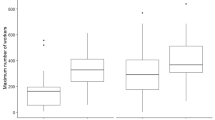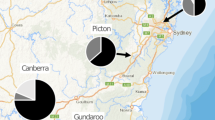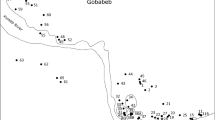Abstract
Wild bumblebee colonies are hard to find and often inaccessible, so there have been few studies of the genetic structure of bumblebees within natural colonies, and hence, it is not clear how frequently events such as worker reproduction, worker drift and queen usurpation take place. This study aimed to quantify the occurrence of natal-worker reproduction, worker drift and drifter reproduction within 14 wild colonies of Bombus terrestris in Central Scotland. Four unlinked microsatellites were used to identify patterns of relatedness of the colonies’ adults and broods. In colonies with queens (queenright colonies), worker reproduction accounted for just 0.83 % of males, increasing to 12.11 % in queenless colonies. Four colonies contained a total of six workers which were not daughters of the queen, and were assumed to be drifters, and four male offspring of drifters. Drifting is clearly not common and results in few drifter offspring overall, although drifters produced approximately seven times more offspring per capita than workers that remained in their natal colony. Unexpectedly, two colonies contained clusters of sister workers and juvenile offspring that were not sisters to the rest of the adults or brood found in the colonies, demonstrating probable egg dumping by queens. A third colony contained a queen which was not a sister or daughter to the other bees in the colony. Although usurping of bumblebee colonies by queens in early season is well documented, this appears to be the first record of egg dumping, and it remains unclear whether it is being carried out by old queens or newly mated young queens.
Similar content being viewed by others
References
Alaux C, Savsrit F, Jaisson P, Hefetz A (2004) Does the queen win it all? Queen–worker conflict over male production in the bumblebee, Bombus terrestris. Naturwissenschaften 91:400–403
Alford DV (1975) Bumblebees. Davis-Poynter Ltd., London
Alves DA, Imperatriz-Fonseca VL, Francoy TM, Santos-Filho PS, Nogueira-Neto P, Billen J, Wenseleers T (2009) The queen is dead—long live the workers: intraspecific parasitism by workers in the stingless bee Melipona scutellaris. Mol Ecol 18:4102–4111
Beekman M, Oldroyd BP (2008) When workers disunite: intraspecific parasitism by eusocial bees. Annu Rev Entomol 53:19–37
Birmingham AL, Winston ML (2004) Orientation and drifting behaviour of bumblebees (Hymenoptera: Apidae) in commercial tomato greenhouses. Can J Zool 82:52–59
Birmingham AL, Hoover SE, Winston ML, Ydenberg RC (2004) Drifting bumble bee (Hymenoptera: Apidae) workers in commercial greenhouses may be social parasites. Can J Zool 82:1843–1853
Bourke AFG, Ratnieks FLW (2001) Kin-selected conflict in the bumblebee Bombus terrestris (Hymenoptera: Apidae). Proc R Soc Lond B 268:347–355
Carvell C, Rothery P, Pywell RF, Heard MS (2008) Effects of resource availability and social parasite invasion on field colonies of Bombus terrestris. Ecol Entomol 33:321–327
Chapman NC, Beekman M, Oldroyd BP (2010a) Worker reproductive parasitism and drift in the western honeybee Apis mellifera. Behav Ecol Sociobiol 64:419–427
Chapman NC, Higgs JS, Wattanachaiyingcharoen W, Beekman M, Oldroyd BP (2010b) Worker reproductive parasitism in naturally orphaned colonies of the Asian red dwarf honey bee, Apis florea. Insectes Soc 57:163–167
Duchateau MJ (1989) Agonistic behaviors in colonies of the bumblebee Bombus terrestris. J Ethol 7:141–151
Duchateau MJ, Velthuis HHW (1989) Development and reproductive strategies in Bombus terrestris. Behaviour 107:186–207
Estoup A, Solignac M, Harry M, Cornuet JM (1993) Characterization of (Gt)N and (Ct)N microsatellites in two insect species: Apis mellifera and Bombus terrestris. Nucleic Acids Res 21:1427–1431
Estoup A, Scholl A, Pouvreau A, Solignac M (1995) Monoandry and polyandry in bumblebees (Hymenoptera: Bombinae) as evidenced by highly variable microsatellites. Mol Ecol 4:89–93
Estoup A, Solignac M, Cornuet JM, Goudet J, Scholl A (1996) Genetic differentiation of continental and island populations of Bombus terrestris (Hymenoptera: Apidae) in Europe. Mol Ecol 5:19–31
Ferrer A, Corbani AC, Dixon AFG, Hemptinne JL (2011) Egg dumping by predatory insects. Physiol Entomol 36:290–293
Free JB (1958) The drifting of honey-bees. J Agric Sci 51:294–306
Funk CR, Schmid-Hempel R, Schmid-Hempel P (2006) Microsatellite loci for Bombus spp. Mol Ecol 6:83–86
Fussell M, Corbet SA (1992) The nesting places of some British bumblebees. J Apicult Res 31:32–41
Goulson D (2010) Bumblebees; their behaviour, ecology and conservation. Oxford University Press, Oxford
Goulson D, Lye GC, Darvill B (2008) Decline and conservation of bumblebees. Annu Rev Entomol 53:191–208
Goulson D, Whitehorn P, Fowley M (2012) Influence of urbanisation on the prevalence of protozoan parasites of bumblebees. Ecol Entomol 37:83–89
Hobbs GA (1965) Ecology of species of Bombus Latr (Hymenoptera - Apidae) in southern Alberta. III. Subgenus Cullumanobombus Vogt. Can Entomol 97:1293–1297
Huth-Schwarz A, León A, Vandame R, Moritz RFA, Kraus FB (2011) Workers dominate male production in the neotropical bumblebee Bombus wilmattae (Hymenoptera: Apidae). Front Zool 8:13. doi:10.1186/1742-9994-8-13
Imhoof B, Schmid-Hempel P (1999) Colony success of the bumble bee, Bombus terrestris, in relation to infections by two protozoan parasites, Crithidia bombi and Nosema bombi. Insectes Soc 46:233–238
Jay SC (1965) Drifting of honeybees in commercial apiaries. I. Effect of various environmental factors. J Apicult Res 4:167–175
Jay SC (1966) Drifting of honeybees in commercial apiaries. II. Effect of various factors when hives are arranged in rows. J Apicult Res 5:103–112
Jay SC (1968) Drifting of honeybees in commercial apiaries. IV. Further studies of the effect of apiary layout. J Apicult Res 7:37–44
Jay SC (1971) Sun position as a possible factor in the disorientation of honeybees (Apis mellifera) (Hymenoptera: Apidae). Can Entomol 103:1111–1114
Knight ME, Martin AP, Bishop S, Osborne JL, Hale RJ, Sanderson RA, Goulson D (2005) An interspecific comparison of foraging range and nest density of four bumblebee (Bombus) species. Mol Ecol 14:1811–1820
Knight ME, Osborne JL, Sanderson RA, Hale RJ, Martin AP, Goulson D (2009) Bumblebee nest density and the scale of available forage in arable landscapes. Insect Cons Div 2:116–124
Lefebvre D, Pierre J (2007) Demographic consequences of drift in contiguous hives of Bombus terrestris. J Econ Entomol 100:1756–1763
Lopez-Vaamonde C, Koning JW, Brown RM, Jordan WC, Bourke AFG (2004) Social parasitism by male-producing reproductive workers in a eusocial insect. Nature 430:557–560
Nanork P, Paar J, Chapman NC, Wongsiri S, Oldroyd BP (2005) Asian honeybees parasitize the future dead. Nature 437:829–829
Nanork P, Chapman NC, Wongsiri S, Lim J, Gloag RS, Oldroyd BP (2007) Social parasitism by workers in queenless and queenright Apis cerana colonies. Mol Ecol 16:1107–1114
Neumann P, Moritz RFA, Mautz D (2000) Colony evaluation is not affected by drifting of drone and worker honeybees (Apis mellifera L.) at a performance testing apiary. Apidologie 31:67–79
O’Connor S, Park KJ, Goulson D (2012) Humans versus dogs; a comparison of methods for the detection of bumble bee nests. Apidologie 51:204–211
Oldroyd BP, Halling LA, Good G, Wattanachaiyingchareon W, Barron AB, Nanork P, Wongsiri S, Ratnieks FLW (2001) Worker policing and worker reproduction in Apis cerana. Behav Ecol Sociobiol 50:371–377
Osborne JL, Martin AP, Shortall CR, Todd AD, Goulson D, Knight ME, Hale RJ, Sanderson RA (2008) Quantifying and comparing bumblebee nest densities in gardens and countryside habitats. J Appl Ecol 45:784–792
Otti O, Schmid-Hempel P (2008) A field experiment on the effect of Nosema bombi in colonies of the bumblebee Bombus terrestris. Ecol Entomol 33:577–582
Packer L (1986) The biology of a subtropical population of Halictus ligatus IV: a cuckoo-like caste. J NY Entomol Soc 94:458–466
Paxton RJ, Thoren PA, Estoup A, Tengo J (2001) Queen–worker conflict over male production and the sex ratio in a facultatively polyandrous bumblebee, Bombus hypnorum: the consequences of nest usurpation. Mol Ecol 10:2489–2498
Pfeiffer KJ, Crailsheim K (1998) Drifting of honeybees. Insectes Soc 45:151–167
Roberts ER, Daniels S, Wardlaw JC, Raybould AF, Pearson JE, Pearson B (1999) Seasonal polydomy: its possible causes and its consequences for kinship and intra-specific parasitism in Leptothorax tuberum (Hymenoptera: Formicidae). Sociobiology 33:199–214
Rutrecht ST, Klee J, Brown MJF (2007) Horizontal transmission success of Nosema bombi to its adult bumble bee hosts: effects of dosage, spore source and host age. Parasitology 134:1719–1726
Sladen FWL (1912) The humble-bee. Logaston Press, Hereford
Takahashi J, Itoh M, Shimizu I, Ono M (2008) Male parentage and queen mating frequency in the bumblebee Bombus ignitus (Hymenoptera: Bombinae). Ecol Res 23:937–942
Takahashi J, Martin SJ, Ono M, Shimizu I (2010) Male production by non-natal workers in the bumblebee, Bombus deuteronymus (Hymenoptera: Apidae). J Ethol 28:61–66
Tallamy DW (2005) Egg dumping in insects. Annu Rev Entomol 50:347–370
Truett GE, Heeger P, Mynatt RL, Truett AA, Walker JA, Warman ML (2000) Preparation of PCR-quality mouse genomic DNA with hot sodium hydroxide and tris (HotSHOT). Biotechniques 29:52–54
Van Honk CGJ, Röseler PF, Velthuis HHW, Hoogeveen JC (1981) Factors influencing the egg laying of workers in a captive Bombus terrestris colony. Behav Ecol Sociobiol 9:9–14
Waters J, O’Connor S, Park K, Goulson D (2010) Testing a detection dog to locate bumblebee colonies and estimate nest density. Apidologie 42:200–205
Whitehorn PR, Tinsley MC, Brown MJF, Darvill B, Goulson D (2009) Impacts of inbreeding on bumblebee colony fitness under field conditions. BMC Evol Biol doi:10.1186/1471-2148-9-152
Zanette LRS, Miller SDL, Faria CMA, Almond EJ, Huggins TJ, Jordan WC, Bourke AFG (2012) Reproductive conflict in bumblebees and the evolution of worker policing. Evol 66:3765–3777
Acknowledgments
We thank the Leverhulme Trust for funding this research and field assistants James Mackenzie, Iain McNicol and Lilly Herridge. We would also like to thank Andrew Bourke and one anonymous reviewer for their useful comments on the manuscript.
Conflict of interest
The authors declare that they have no conflict of interest.
Author information
Authors and Affiliations
Corresponding author
Additional information
Communicated by M. Beekman
Electronic supplementary material
Below is the link to the electronic supplementary material.
ESM 1
(XLSX 84 kb)
Rights and permissions
About this article
Cite this article
O’Connor, S., Park, K.J. & Goulson, D. Worker drift and egg dumping by queens in wild Bombus terrestris colonies. Behav Ecol Sociobiol 67, 621–627 (2013). https://doi.org/10.1007/s00265-013-1481-1
Received:
Revised:
Accepted:
Published:
Issue Date:
DOI: https://doi.org/10.1007/s00265-013-1481-1




